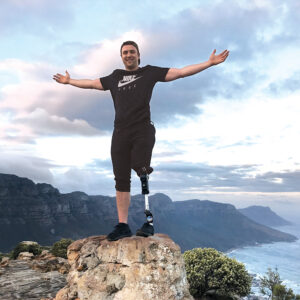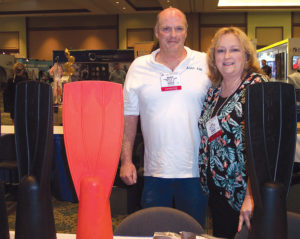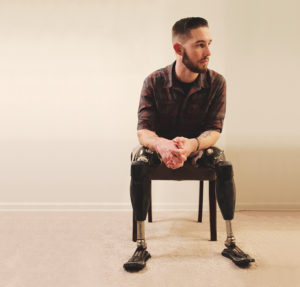By Elan Young
Inherent in the entrepreneurial spirit is a mindset focused on finding solutions and making change rather than waiting for others to do so. Being out in front of a problem has its rewards, and entrepreneurs are often known for braving the unknown, engaging in critical thinking, innovating, and fine-tuning processes that lead to a desired result. It takes grit, courage, a dogged belief in oneself, and the enterprise to start and run a business. Even then, a widely reported statistic cites a 90 percent failure rate among new businesses within the first five years. For entrepreneurs with limb loss and limb difference hoping to make an impact in the O&P industry, there is a common thread of shared experiences and wanting to change the industry and make life better for others with limb difference.

Three entrepreneurs in the O&P field who have their own personal experiences with limb loss to back up their knowledge speak to this greater motivation for impacting human lives, as well as the challenges they’ve had to go through to implement their concepts.
Jedidiah Morgan was in the Marine Corps deployed to Afghanistan when on June 20, 2012, while he was conducting a foot patrol, he triggered an improvised explosive device that resulted in the loss of both his legs above the knee and damage to his right hand.

“I chose this industry, one, because I am an amputee myself and can better understand what needs to change or improve and, two, because of product ideas I had that were not currently on the market yet, but could change many people’s lives for the better,” he says. “I feel that being an amputee myself allows me to have a greater level of understanding. I can sympathize with other amputees on the issues they are facing, and I can also better articulate what changes they need to make in order to fix any problems because I know what it feels like.”
This direct experience led Morgan to found Sergius Industries, a company that makes prosthetic and orthotic components, as well as the Amputee Repair Kit (ARK), which is similar to a first aid kit for anyone who wears a prosthesis. It includes items amputees need to care for their prostheses and residual limbs and comes in three sizes–home, vehicle, and travel. It was carefully designed to help prosthesis users achieve comfort and safety as their prosthetic components and skin constantly experience wear and tear. “Up until now, an amputee would have to purchase individual items for each type of maintenance or repair,” says Morgan.
In 1985, Randy Lord, creator of the Amp Fin, had a workplace accident that crushed his right ankle. After two ankle fusions failed, he was left with the possibility of amputation. Four years later, he had his leg amputated below the knee, followed by a revision. All of this was devastating to Lord, who grew up in Maine and spent his life around, on, and in the water.
In 1993, he met his wife Lori, who also grew up near the coast and loved the water. She wondered why he didn’t like to go to the beach and swim, knowing how much he loved the water. He replied that it was not fun for an amputee to walk in the sand, and once in the water, what’s there to do? Lori then asked what they could do to change this, which sparked their journey to create the Amp Fin.
Over the next few years, they bought hundreds of fins at yard sales to cut them up trying to come up with something that he could use to get back into the water in a more enjoyable way.
The business of their construction company put the project on hold for a few years, but in 2004 when they saw enlisted men and women returning from Iraq with all kinds of horrendous injuries including limb loss, Lord remembered the advice he’d been given by an amputee veteran: Attitude and patience is the key to getting through. He knew he wanted to help veterans and others with limb loss, so he and Lori began working on the project again, but with a much bigger purpose.
“As an amputee, I know what other people with limb loss are going through, whereas others can only imagine,” Lord says.
He and Lori unsuccessfully searched the internet for solutions, so they set out to make a fin by creating molds. After seven years of trial and error, they created a fin with no leverage or chafing issues and that would allow swimmers to put their prosthetic leg back on as if they had never been in the water. Finally, the Lords received their patent in 2014. The name Amp Fin stands for American-made Prosthetic Fin.
“If it was not for Lori and her desire to get me back into the water and her determination and our returning veterans, we would not have finished the project,” Lord says. “The VA has now started to pick up the cost, including Walter Reed Hospital.”
In the developing world, 90 percent of lower-limb amputees don’t have access to a prosthetic device. Even those who do, often don’t get access to a high-functioning prosthetic device that can truly restore their mobility, enhance their quality of life, and enable them to return to school or the workforce. This is one of the reasons Brandon Burke helped found LegWorks, with the mission of enabling amputees globally to walk with confidence.

Burke was diagnosed with stage IV Ewing’s sarcoma at the age of 16, which resulted in a limb-salvage surgery that eventually failed. At age 18, he underwent an above-knee amputation to return to an active lifestyle. The medical care Burke received helped him understand the privilege of living in the United States with access to world-class healthcare, and it also made him understand that the “best” isn’t always what is right for a person.
LegWorks is focused on developing the highest-functioning prosthetic devices in categories of products that can be manufactured affordably and are durable, environmentally resistant, and low-maintenance. Currently, the company is focused on prosthetic knees with a line of products that utilize two novel technologies that Burke says significantly improve the functional capabilities of mechanical knees. “I wear our product, the All-Terrain Knee, and it’s my ultimate vision that amputees globally, including the 90 percent that don’t currently have access, can not only wear the same knee as me, but that they can get access to the same complete prosthesis as me,” says Burke.
Even though Burke’s amputation was the catalyst for LegWorks, he had long been inspired toward entrepreneurship after a course at Vanderbilt University that introduced him to the concept of social enterprise. “Up until that point, I had only thought the intention of business was to generate money and profit; I had never realized that businesses are best when they are fundamentally based on solving problems and providing great services, that the profit generated can be then used as a means toward solving greater challenges and serving more people,” he says. “Having been affected by cancer and becoming an amputee, I immediately thought about how this principle could be applied to help serve the unmet need for quality prosthetic care in the developing world and the potential for impact with applying this approach.”
It takes grit to be an entrepreneur, and for those trying to break into the O&P industry, the road can be particularly challenging. These three entrepreneurs are not alone in having encountered problems, limitations, and setbacks on their journeys, yet often that’s what ultimately inspired them to enter a niche market to try to solve problems for others facing similar challenges. Through their lived experience and a compassionate desire to help others, they are filling gaps in the market for others with limb loss and limb difference.



